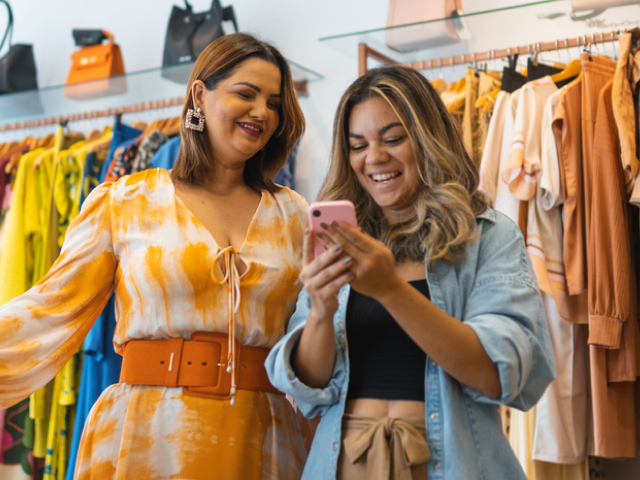Everything you need to know about retail clienteling
Clienteling is essential for building lasting customer relationships and driving sales growth.
This comprehensive guide will explore what clienteling is, its benefits for both retailers and customers, how to implement effective clienteling strategies, and the role of technology in enhancing the clienteling experience.
We’ll also provide actionable tips and best practices to help you master clienteling and achieve a significant return on investment.
What is clienteling?
Clienteling is the process of building relationships between sales associates and customers through personalized service. It involves using customer data and technology to create tailored shopping experiences and foster long-term loyalty.
Clienteling goes beyond traditional customer service. While customer service focuses on addressing inquiries and resolving issues, clienteling is a proactive approach aimed at understanding individual customer needs and preferences to provide personalized recommendations and build ongoing relationships.
Clienteling also encompasses “virtual clienteling,” which extends personalized service across digital channels like email, SMS, and online chat. “Omnichannel clienteling” integrates both online and offline interactions to create a seamless and consistent customer experience across all touchpoints.
Why clienteling is more important than ever
The retail landscape has dramatically changed with the rise of eCommerce and digital technologies. Customers now expect personalized experiences and tailored interactions. In fact, 80% of consumers are more likely to purchase from a brand that provides personalization.
Clienteling helps retailers differentiate themselves, build customer loyalty, and thrive in this competitive environment by fostering meaningful connections and providing value beyond the transaction.
How clienteling benefits customers and retailers
Clienteling creates a mutually beneficial relationship for both customers and retailers.
Benefits for customers
- Personalized service: Customers receive tailored recommendations, timely offers, and exclusive content based on their individual needs and preferences.
- Enhanced shopping experience: Clienteling creates a more engaging, convenient, and enjoyable shopping journey.
- Stronger relationships: Customers feel valued, understood, and connected to the brand, leading to increased trust and loyalty.
Benefits for retailers
- Increased customer loyalty: Personalized service and strong relationships lead to higher customer retention rates and lifetime value. A 5% increase in customer retention can increase profits by 25% to 95%.
- Higher sales and revenue: Clienteling drives repeat purchases, larger transactions, and improved conversion rates through personalized recommendations and targeted promotions.
- Valuable customer data and insights: Clienteling provides retailers with valuable data on customer preferences, behavior, and feedback, enabling them to make informed decisions.
- Optimized inventory management: Clienteling data helps retailers anticipate customer demand and preferences, leading to more efficient inventory management and reduced costs.
- Competitive advantage: Clienteling differentiates retailers from competitors by providing a superior customer experience and building stronger customer relationships.
Technology’s role in clienteling strategy
Technology empowers retailers to develop deeper, more meaningful customer relationships through clienteling.
- Mobile applications: Mobile apps extend clienteling beyond the store, allowing for personalized interactions on customers’ smartphones. Retailers can use apps to provide tailored product recommendations, exclusive content, and real-time communication with sales associates, fostering a continuous clienteling relationship.
- Customer Relationship Management (CRM) systems: A Clienteling CRM is the central hub for customer data, storing purchase history, preferences, contact information, and interaction logs. This centralized data empowers sales associates to access a 360-degree view of each customer, enabling them to provide highly personalized recommendations and anticipate needs. For example, a CRM can alert an associate to a customer’s birthday or anniversary, prompting a personalized message or offer.
- Artificial Intelligence (AI): AI enhances clienteling by automating personalized recommendations and offers. AI algorithms can analyze customer data to identify patterns and predict future purchases, enabling retailers to proactively suggest relevant products and services. This level of personalization strengthens the clienteling relationship by demonstrating a deep understanding of the customer’s needs.
- Mobile Point of Sale (mPOS): mPOS solutions enable associates to provide personalized service anywhere in the store. By accessing customer data on a mobile device, associates can offer tailored recommendations, look up product information, and complete transactions without the customer having to wait in line. This enhances the clienteling experience by making it more convenient and efficient.
Creating a personalized customer experience
Personalized experiences are crucial for success in today’s retail environment. 78% of consumers will only engage with offers if they are personalized.
Creating a personalized experience involves:
- Understanding customer needs and preferences.
- Tailoring interactions and offers accordingly.
- Building an emotional connection with the customer.
- Tracking customer behavior and purchase history.
How to use data and analytics to improve customer service
Data and analytics are essential for delivering personalized and efficient customer service and clienteling.
- Collecting customer data through digital platforms provides insights into customer preferences and needs.
- This data can be used to develop customer profiles, personalize outreach, and optimize store operations.
- For example, purchase history can inform decisions about product recommendations and promotions.
- Analytics can also track customer behavior in-store to improve efficiency and customer satisfaction.
Clienteling strategies
Implementing effective clienteling strategies is crucial for building strong customer relationships and driving sales. Here are some key clienteling best practices:
- Customer segmentation: Segment customers into groups based on demographics, purchase history, preferences, and behavior to provide tailored service and personalized communication.
- Personalized communication: Use customer data to create tailored messages and interactions across all channels, including personalized emails, SMS messages, and in-store conversations.
- Tailored product recommendations: Provide personalized product recommendations based on customer purchase history, preferences, and needs.
- Loyalty programs and rewards: Offer exclusive rewards and perks to loyal customers to encourage repeat business and strengthen relationships.
- Omnichannel clienteling: Integrate online and offline clienteling efforts to create a consistent customer experience across all channels.
How clienteling can help drive sales
Clienteling is a powerful tool for driving sales and revenue growth.
- By understanding individual customer preferences, retailers can design tailored offers and promotions that incentivize purchases.
- Clienteling enables associates to proactively reach out to customers with personalized recommendations and new product arrivals, driving increased sales and larger transactions.
- Clienteling also increases customer lifetime value and repeat purchases, leading to long-term revenue growth.
Best practices for implementing clienteling
To maximize the effectiveness of clienteling, retailers should follow these best practices:
- Use the right tools: Implement a CRM system to store, manage, and analyze customer data, and equip associates with mobile devices to access customer information and provide personalized service on the go.
- Ensure accurate customer data: Collect and regularly update customer data, including purchase history, preferences, and feedback, to ensure accurate personalization.
- Provide ongoing training and education: Train employees on clienteling best practices, product knowledge, and communication skills to ensure they can effectively engage with customers and provide personalized service.
- Build genuine connections: Encourage employees to build authentic relationships with customers by actively listening, showing empathy, and demonstrating a genuine interest in their needs.
- Use customer feedback: Actively solicit and utilize customer feedback to improve clienteling strategies and enhance the overall customer experience.
- Measure success and adjust strategies: Track key metrics such as customer retention rate, customer lifetime value, and average order value to evaluate the effectiveness of clienteling efforts and make data-driven adjustments
Bringing it all together
In conclusion, clienteling is no longer a “nice-to-have” but a fundamental strategy for retail success in 2025 and beyond.
By prioritizing personalized customer relationships, leveraging technology to enhance interactions, and implementing the strategies outlined in this guide, retailers can build lasting loyalty, drive significant revenue growth, and create a truly differentiated brand experience.
The future of retail belongs to those who embrace clienteling and make customer connection their core focus.
Learn more
To learn more about the #1 clienteling solution that is trusted by the world’s most iconic retailers like Saks Fifth Avenue, Versace, COACH, Michael Kors, Jimmy Choo, and more, check out our brochure.
If you’re ready to see it in action, book a demo with our team— we’d love to help you see how Tulip Clienteling can transform your retail experience.
Recommended reads
If you liked this blog, check out these other titles:


